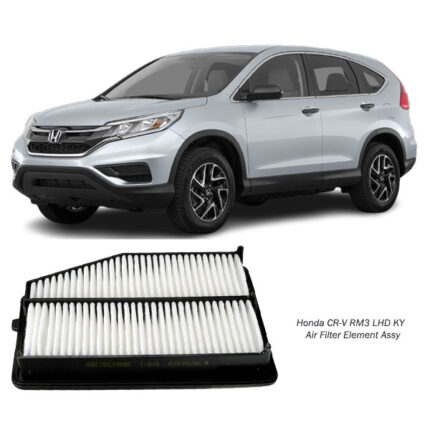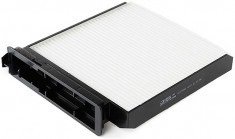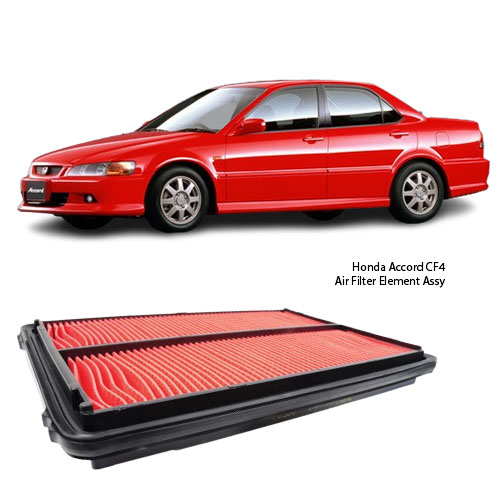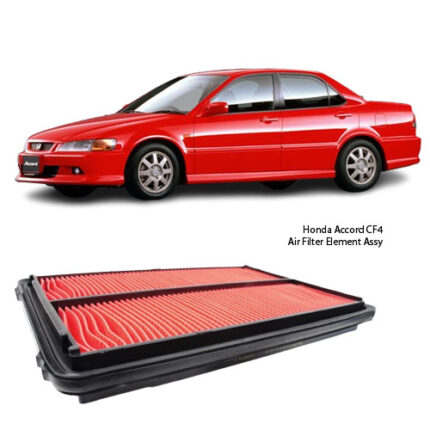Get Honda Accord CF4 Air Filter Element Assy A858J in Kenya
The Air Filter Element Assembly consists of the actual filter material (element), housed within a durable frame or casing that fits snugly into the engine’s air intake system. The filter element is usually made from pleated paper, foam, cotton, or synthetic materials. These materials are chosen for their high filtration capability and airflow efficiency.
This assembly is typically located within the air filter box, often near the front of the engine bay to access cool, fresh air. The structure ensures air flows through the filter material before entering the engine’s intake manifold.
Purpose and Function
-
Air Purification
The primary function of the air filter element assembly is to remove dust, sand, soot, and other airborne contaminants from the intake air. Clean air is vital for combustion efficiency. -
Engine Protection
If contaminants enter the engine, they can cause significant internal wear—especially to pistons, cylinders, and valves. The filter prevents this damage. -
Improved Combustion
Engines require a precise air-fuel mixture. Clean air ensures optimal combustion, which leads to better fuel efficiency and lower emissions. -
Component Longevity
By keeping the air intake system clean, the air filter extends the lifespan of other components like the Mass Air Flow (MAF) sensor, turbocharger (if present), and the engine itself.
Advantages of a Good Air Filter Element Assembly
-
Enhanced Engine Performance
High-quality air filters provide optimal airflow while still capturing harmful particles, allowing the engine to breathe freely and produce consistent power. -
Fuel Efficiency
When the engine gets the right amount of clean air, it burns fuel more efficiently. This can translate to better mileage and cost savings in the long term. -
Lower Emissions
Clean combustion leads to fewer unburned hydrocarbons, carbon monoxide, and nitrogen oxides being emitted from the exhaust system. -
Reduced Maintenance Costs
A good air filter minimizes engine wear and keeps sensors and valves cleaner, reducing the frequency and cost of repairs. -
Longer Engine Life
By protecting the engine from abrasive contaminants, a good filter contributes to a longer, trouble-free engine lifespan.
Disadvantages of a Poor-Quality or Worn-Out Air Filter
-
Restricted Airflow
A clogged or low-quality filter restricts airflow to the engine, causing it to struggle, lose power, and perform inefficiently. -
Increased Fuel Consumption
When the air supply is insufficient, the fuel-air ratio is disrupted. The engine may compensate by using more fuel, resulting in poor fuel economy. -
Higher Emissions
Dirty air filters contribute to incomplete combustion, leading to elevated emission levels and possibly failing emissions tests. -
Engine Damage
If the filter is torn or poorly fitted, dust and debris can enter the engine, causing accelerated wear of internal components. -
Unstable Idle and Poor Acceleration
Insufficient air supply affects combustion stability, leading to rough idling, stalling, or sluggish acceleration.
Signs of a Worn-Out or Failing Air Filter
-
Reduced Engine Power
A noticeable drop in engine performance, especially during acceleration, can indicate a clogged air filter. -
Poor Fuel Economy
A sudden increase in fuel consumption without other obvious causes is a common sign of restricted airflow due to a dirty filter. -
Black Smoke from Exhaust
When too much fuel is burned due to poor air intake, black smoke may emit from the exhaust. -
Check Engine Light
A blocked air filter can trigger warning lights on the dashboard, especially if it affects sensors like the MAF. -
Unusual Engine Sounds
A popping or coughing sound from the engine could signal airflow restriction or improper air-fuel mixture. -
Visual Inspection
When the filter looks dirty, clogged, or blackened with soot, it’s due for replacement.
How to Replace the Air Filter Element Assembly
Tools Needed:
– Screwdriver or socket set (depending on the air box design)
– New air filter element assembly
Steps to Replace:
-
Turn Off the Engine
Ensure the vehicle is turned off and parked on a level surface. -
Locate the Air Filter Housing
Open the bonnet and find the air filter box. It’s usually a black plastic box connected to the intake tube. -
Open the Air Filter Box
Undo screws, clips, or fasteners holding the box closed. -
Remove the Old Filter
Take out the old air filter element and inspect it for dirt and debris. -
Clean the Housing
Wipe the inside of the housing with a clean, damp cloth to remove dust or debris. -
Install the New Filter
Place the new filter element into the housing, ensuring it fits snugly and is seated properly. -
Secure the Housing
Close the air filter box and reattach all clips or screws tightly.
Maintenance Tips
-
Regular Checks: Inspect the air filter every 10,000–15,000 km or during routine servicing.
-
Replace When Necessary: Don’t wait until the filter is completely clogged—replace it according to your vehicle’s service schedule or sooner in dusty environments.
-
Use Quality Parts: Invest in genuine or high-quality aftermarket filters for the best protection and performance.
-
Avoid Over-Oiling (for reusable filters): If using oiled cotton filters (like K&N types), avoid excessive oiling after cleaning, as excess oil can damage sensors.
Follow us on Facebook for more parts.




